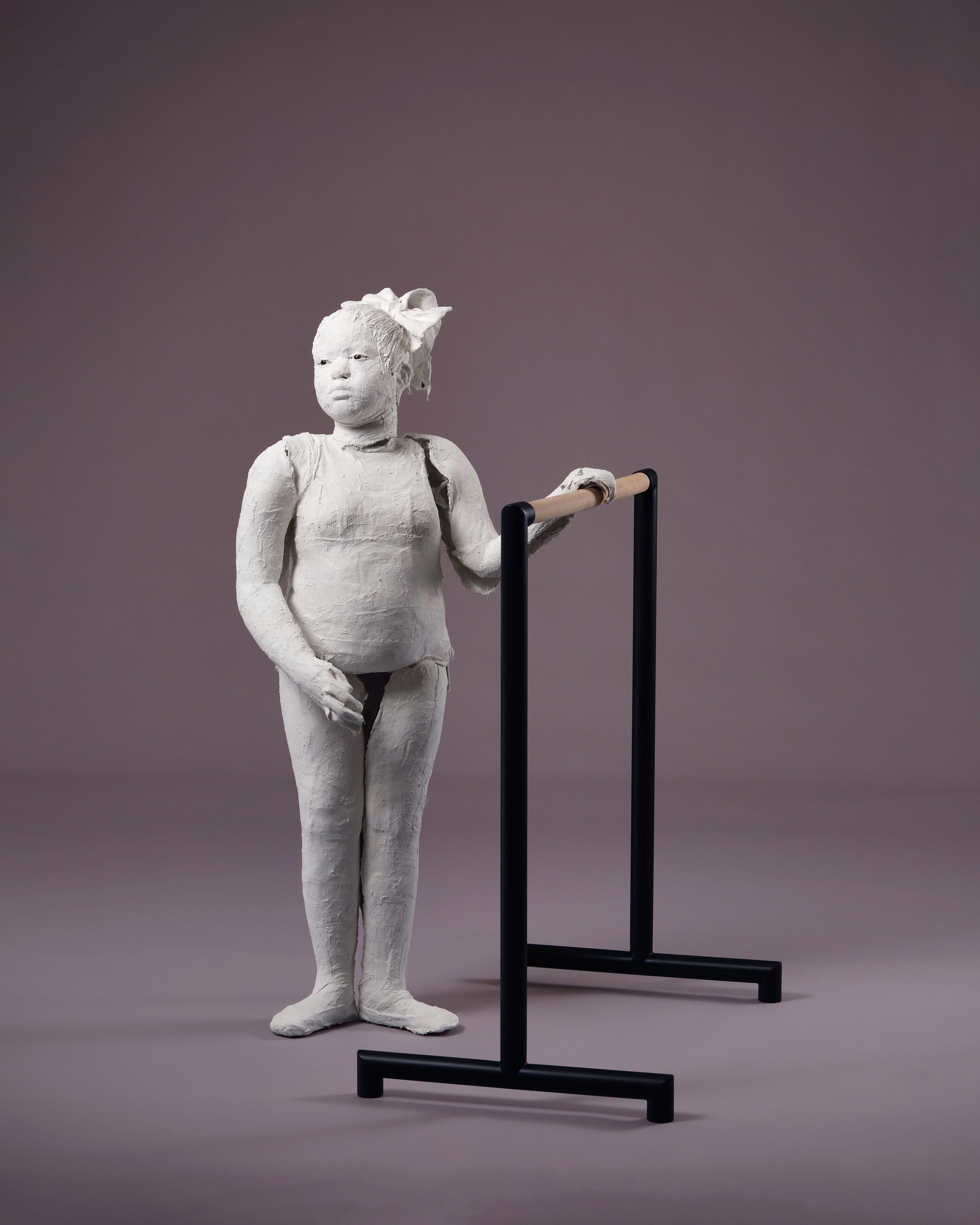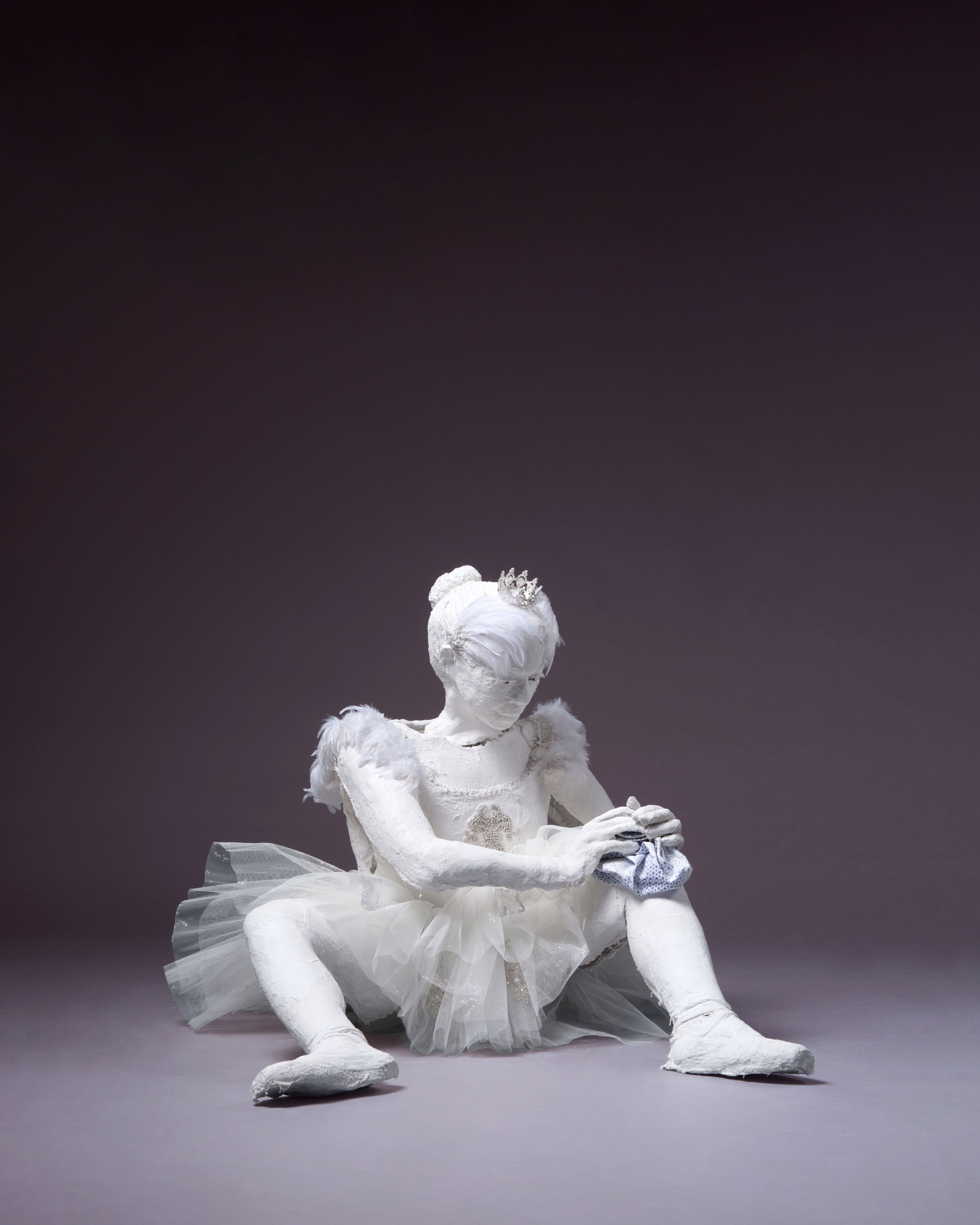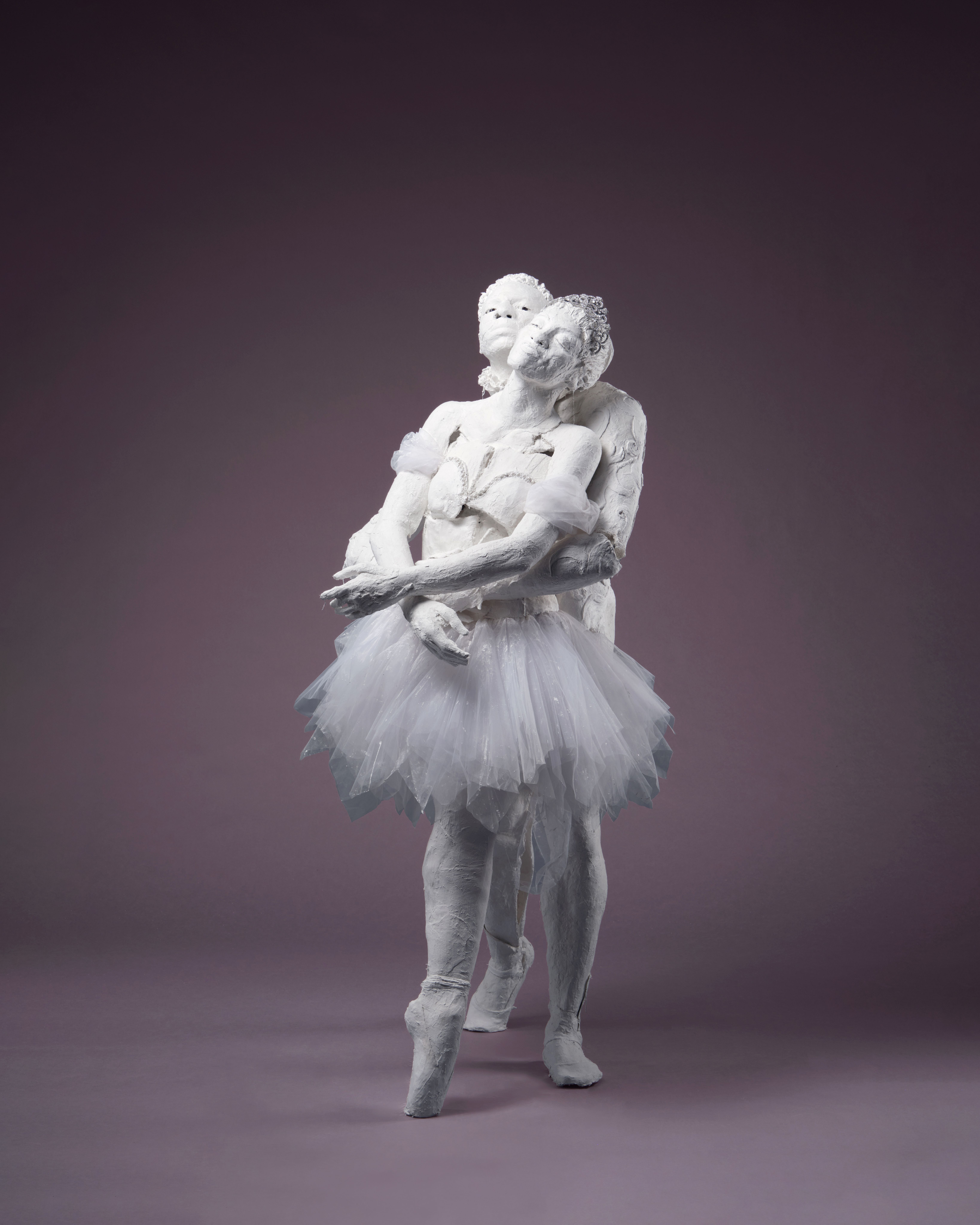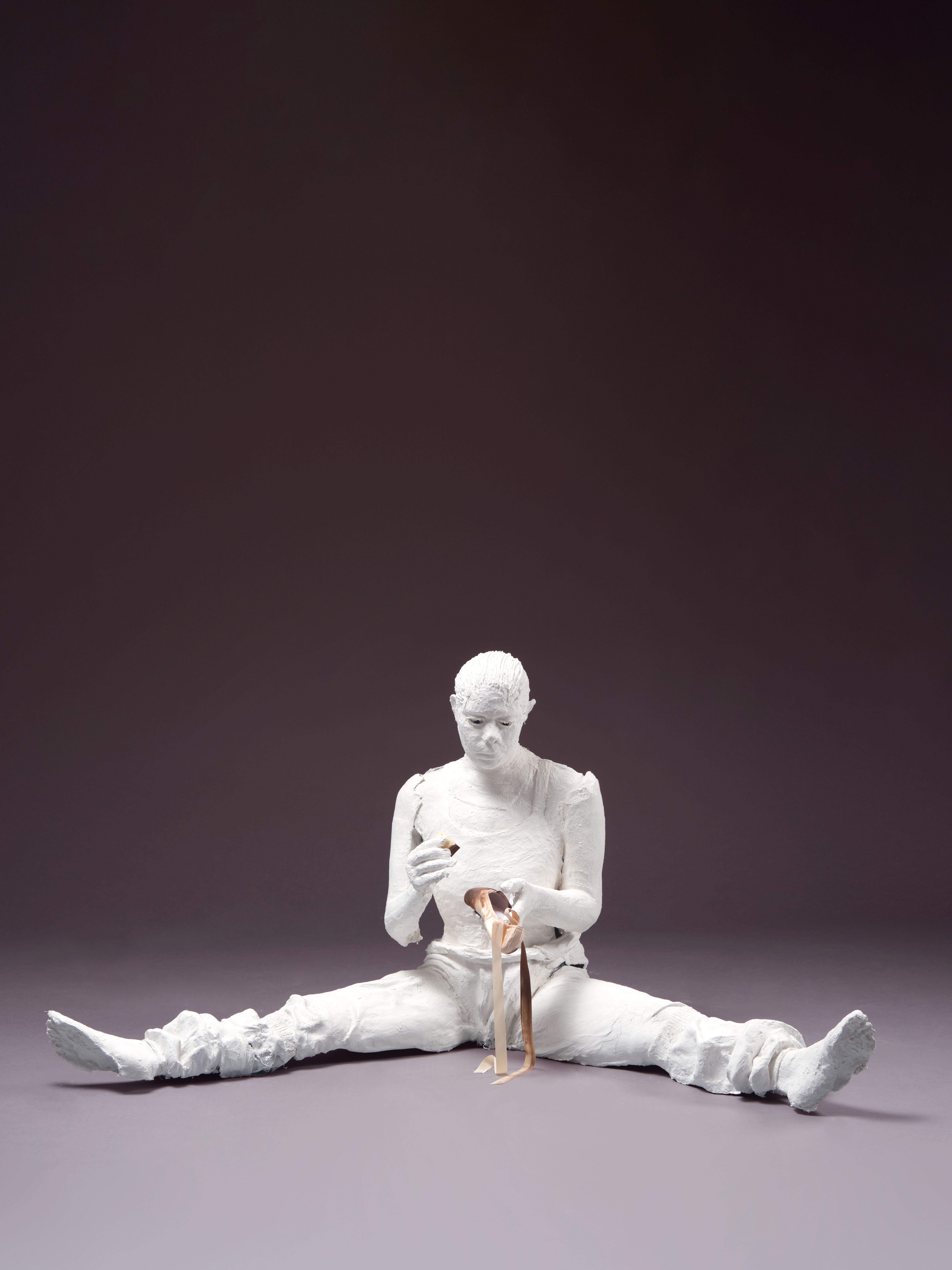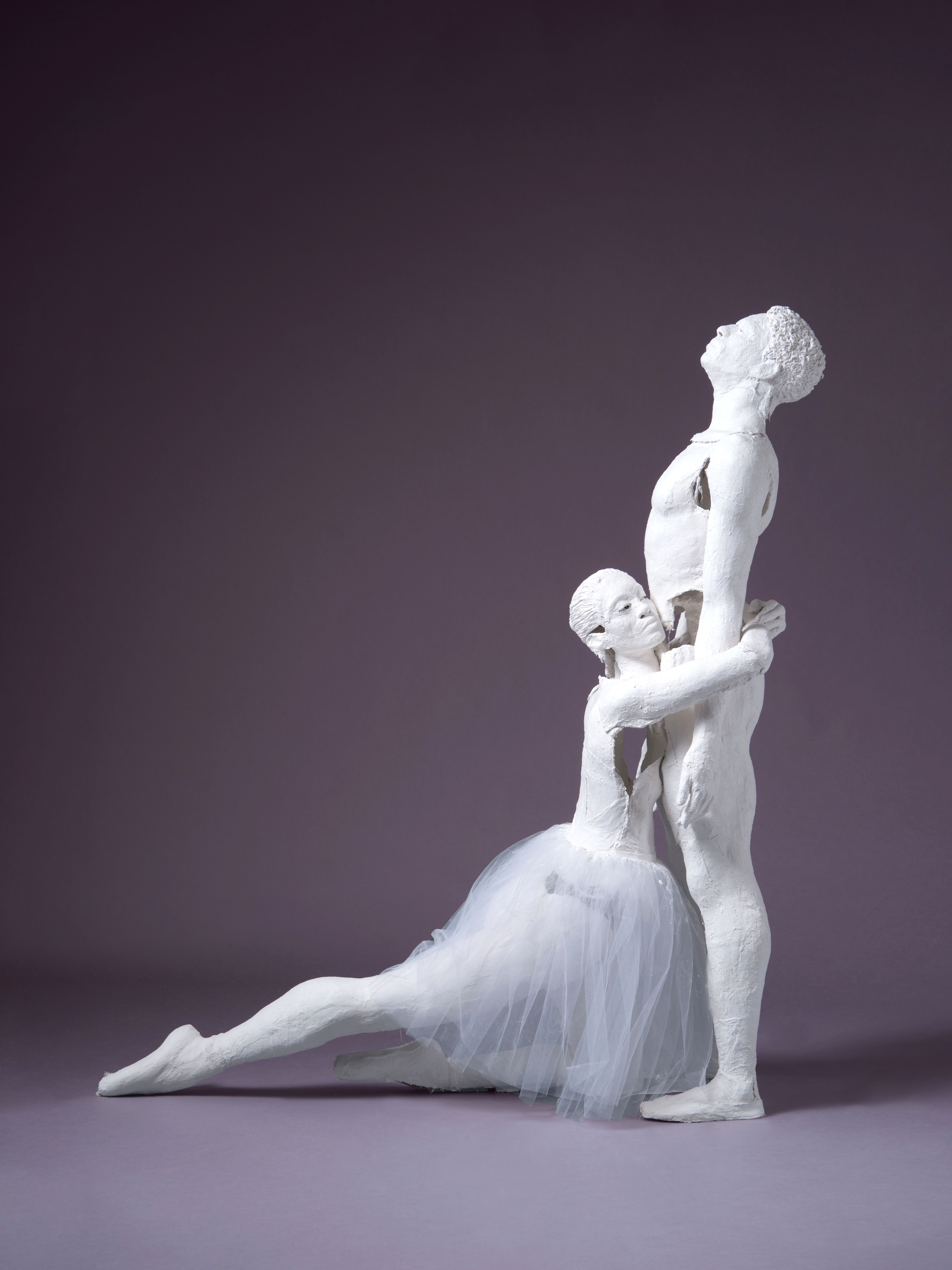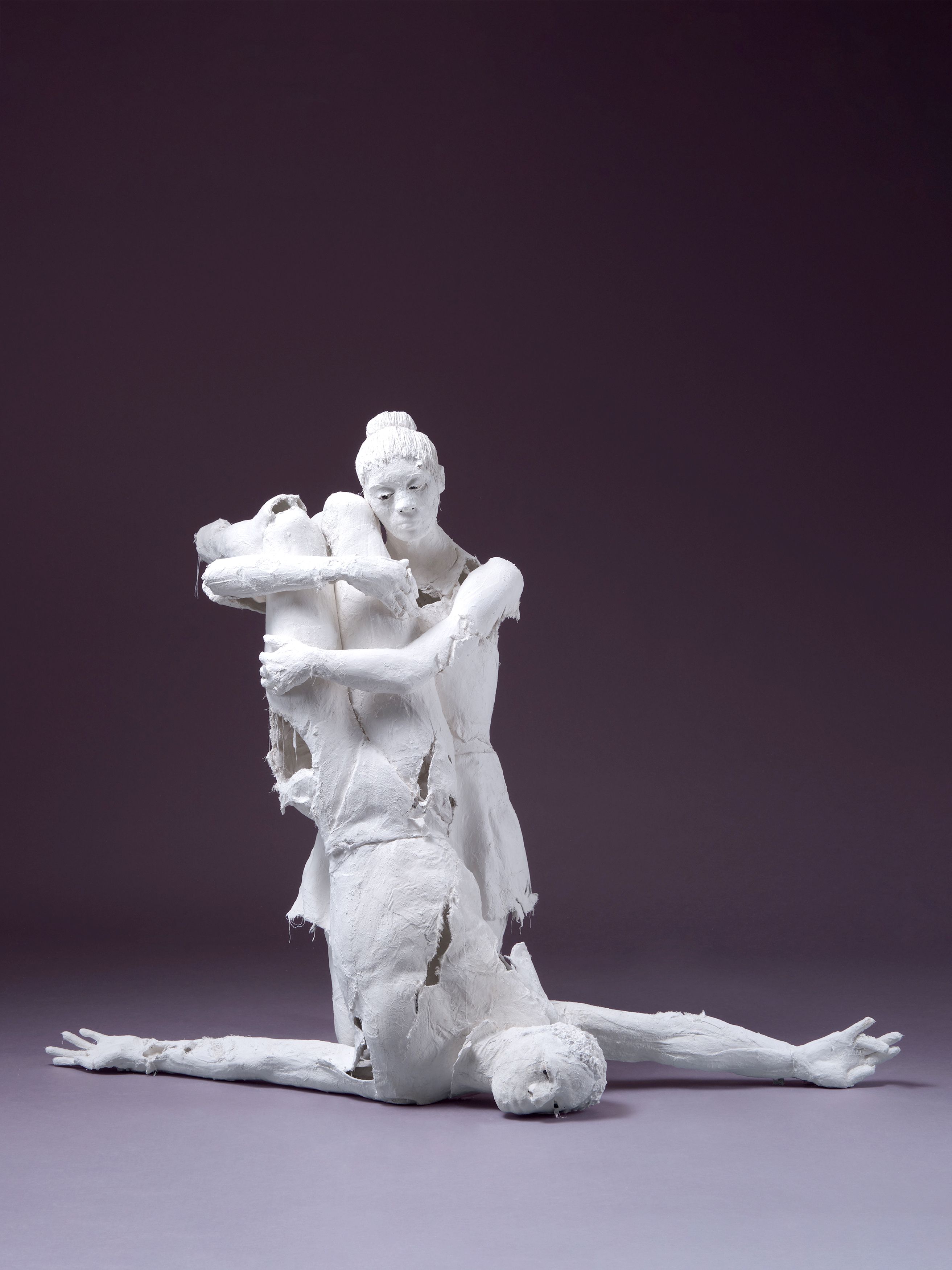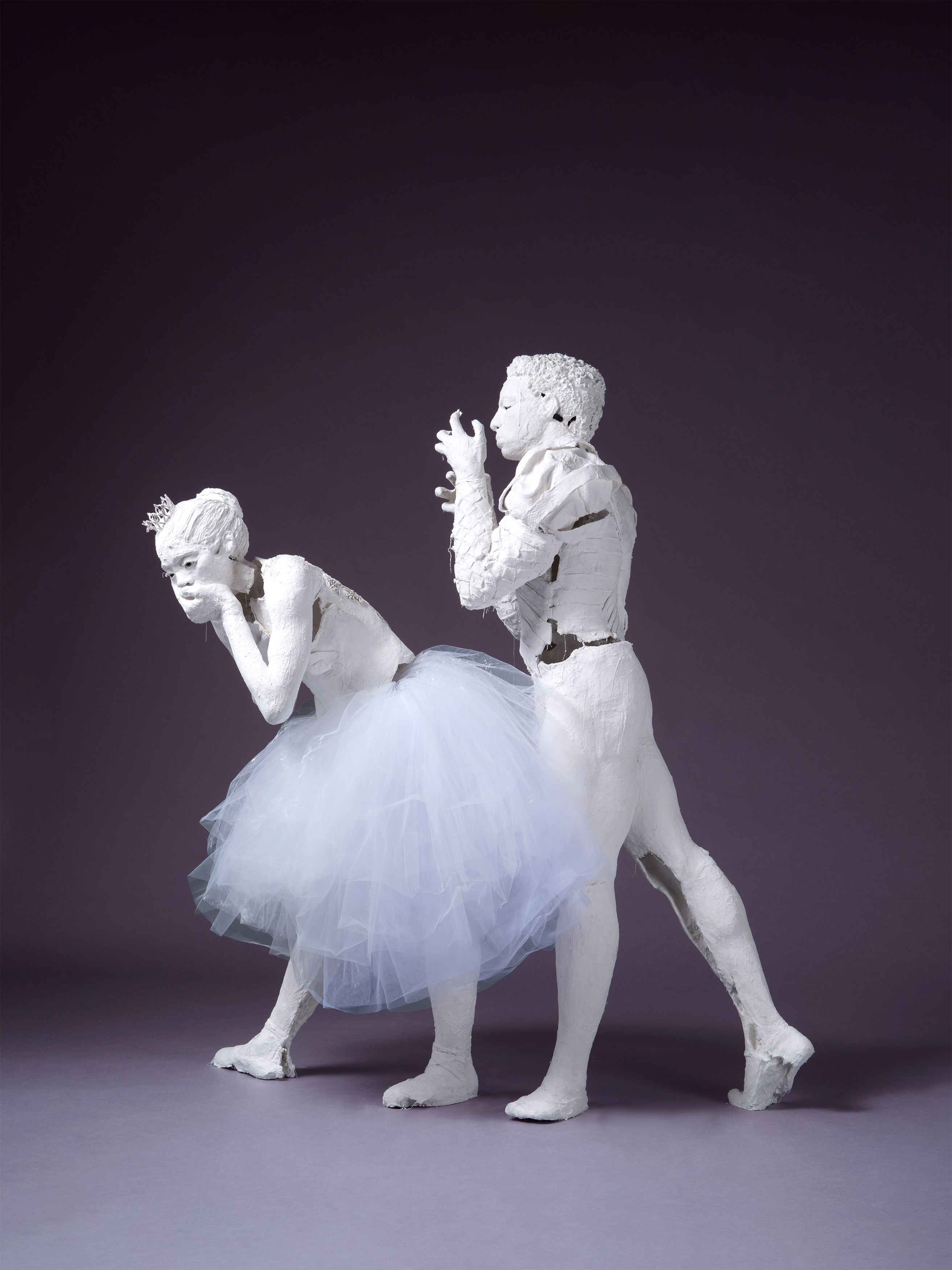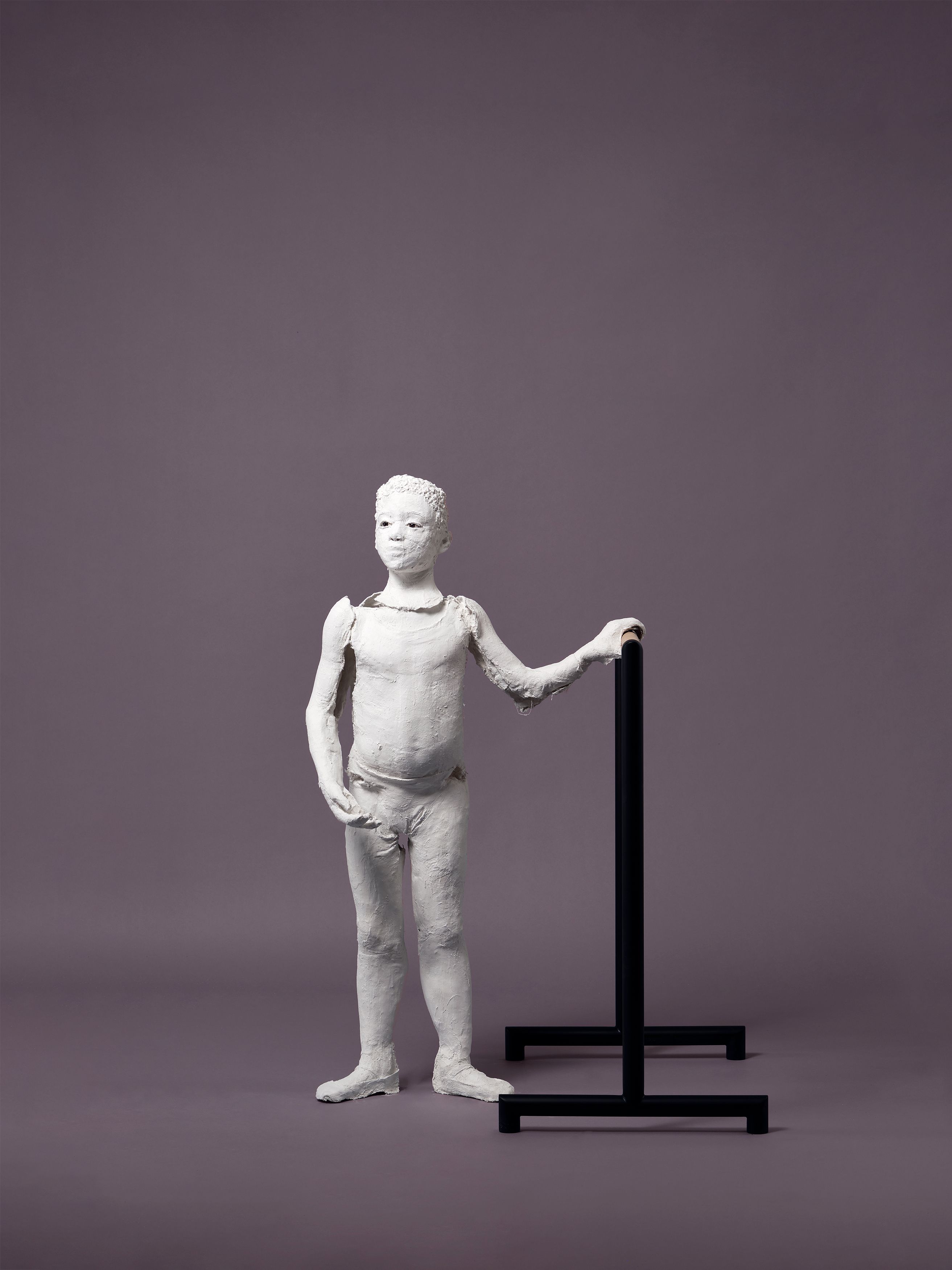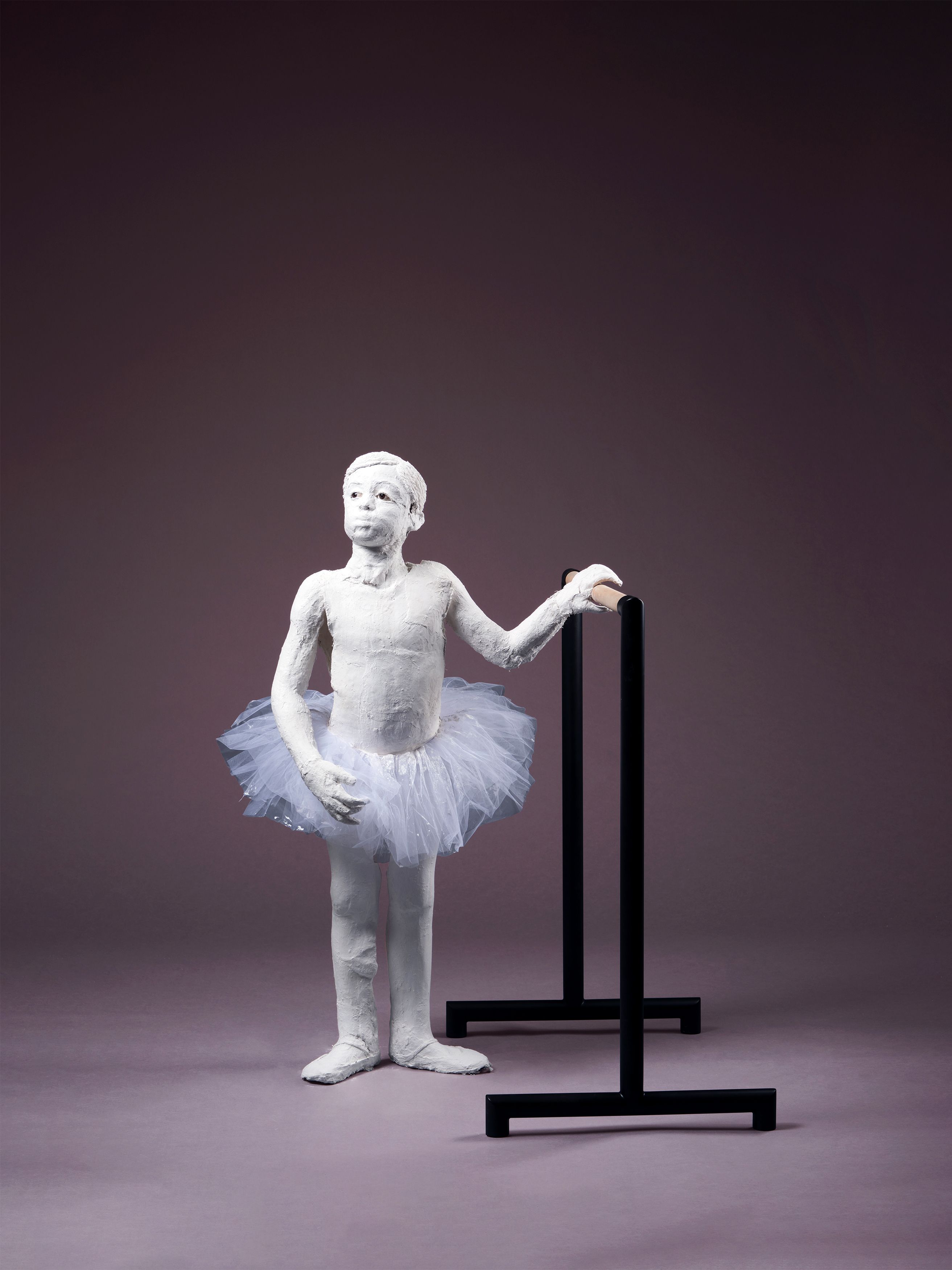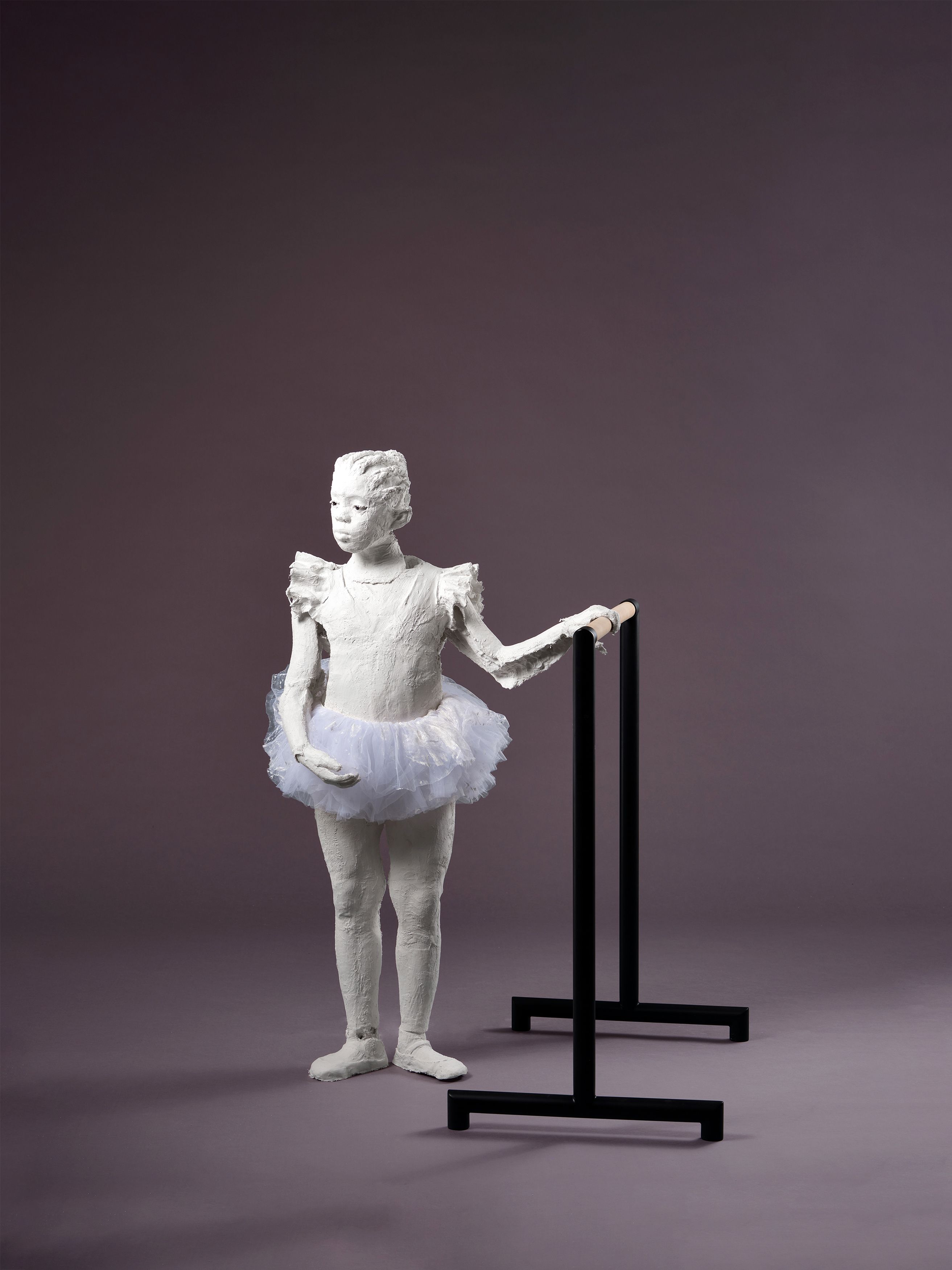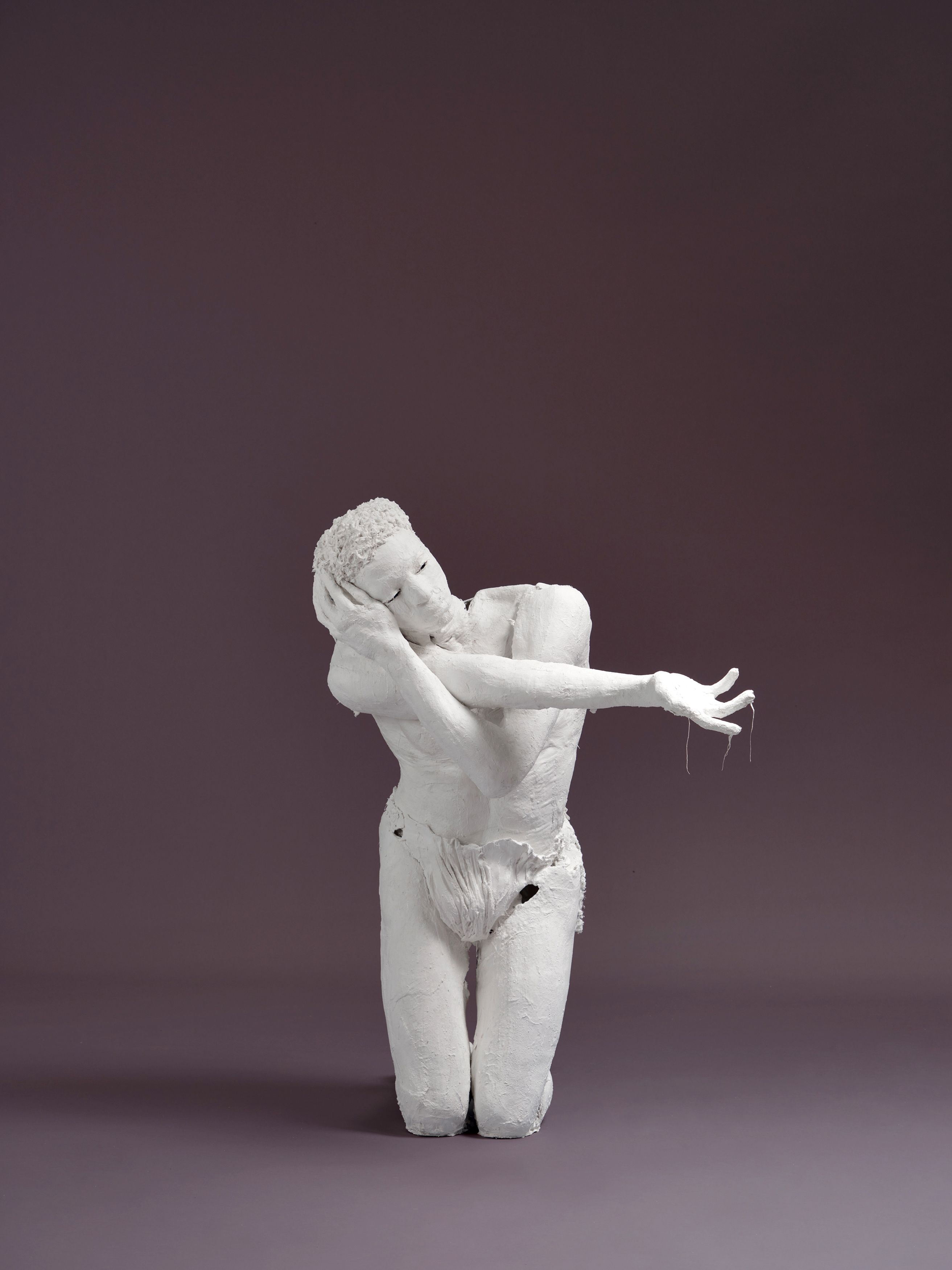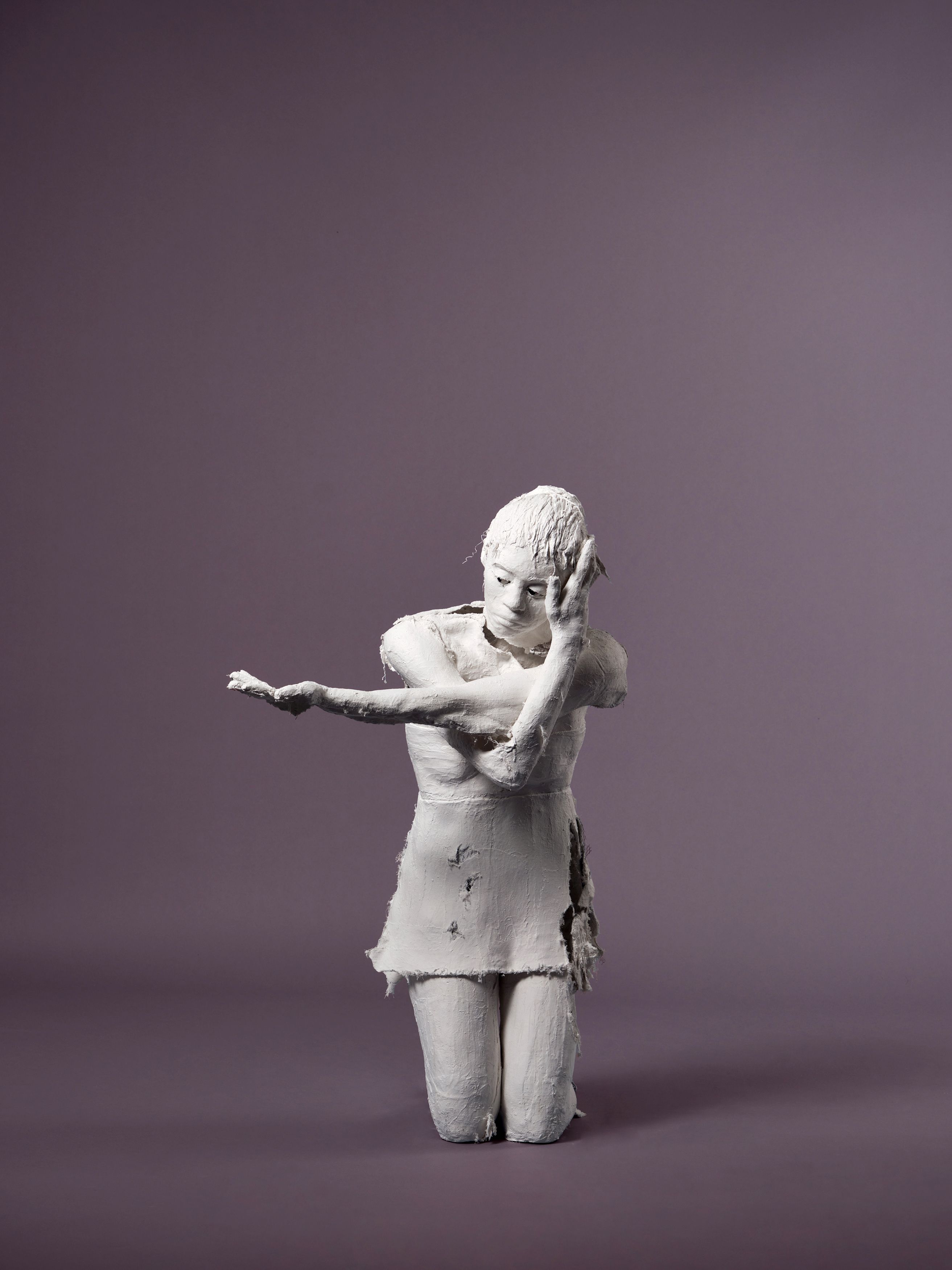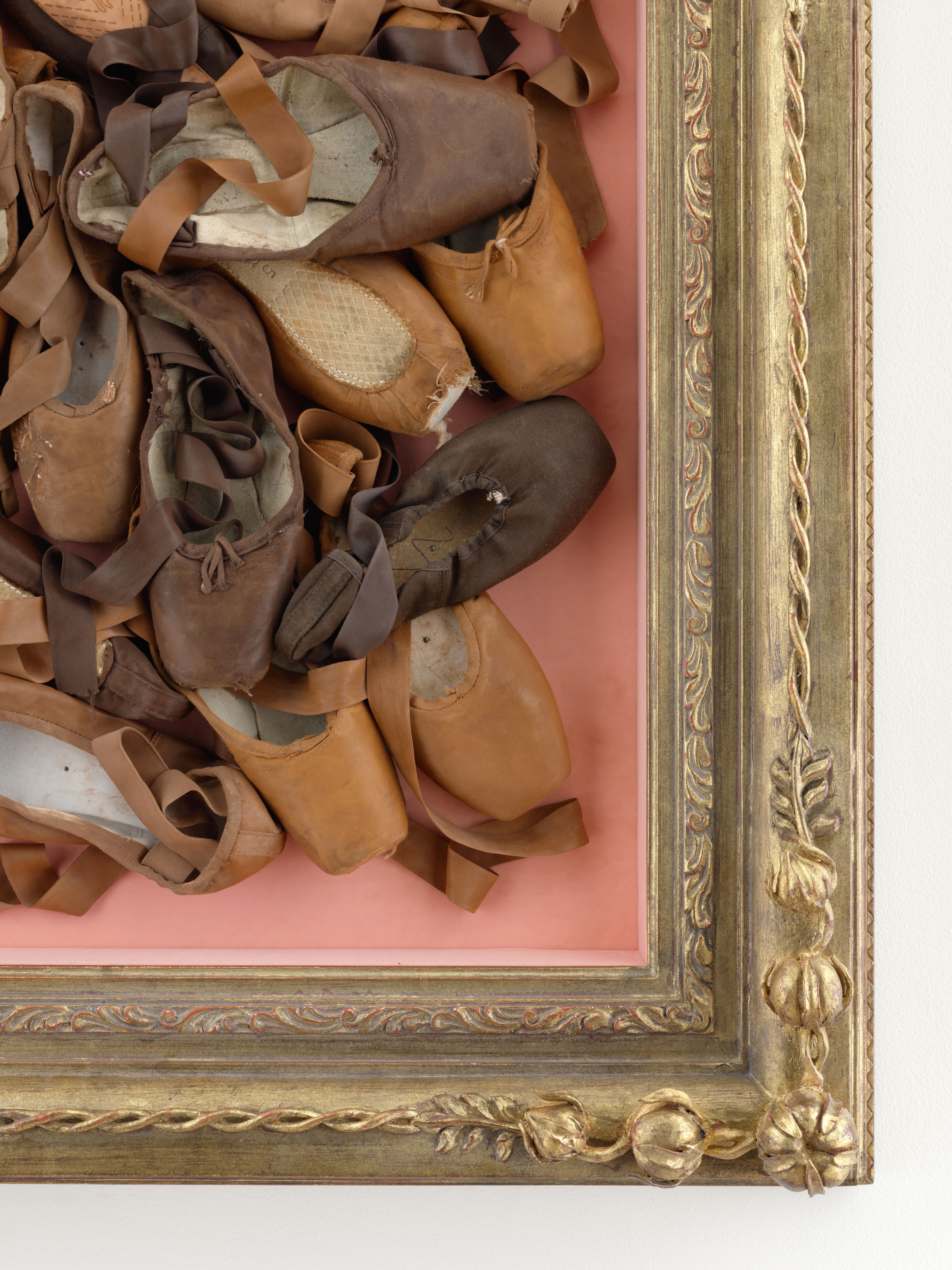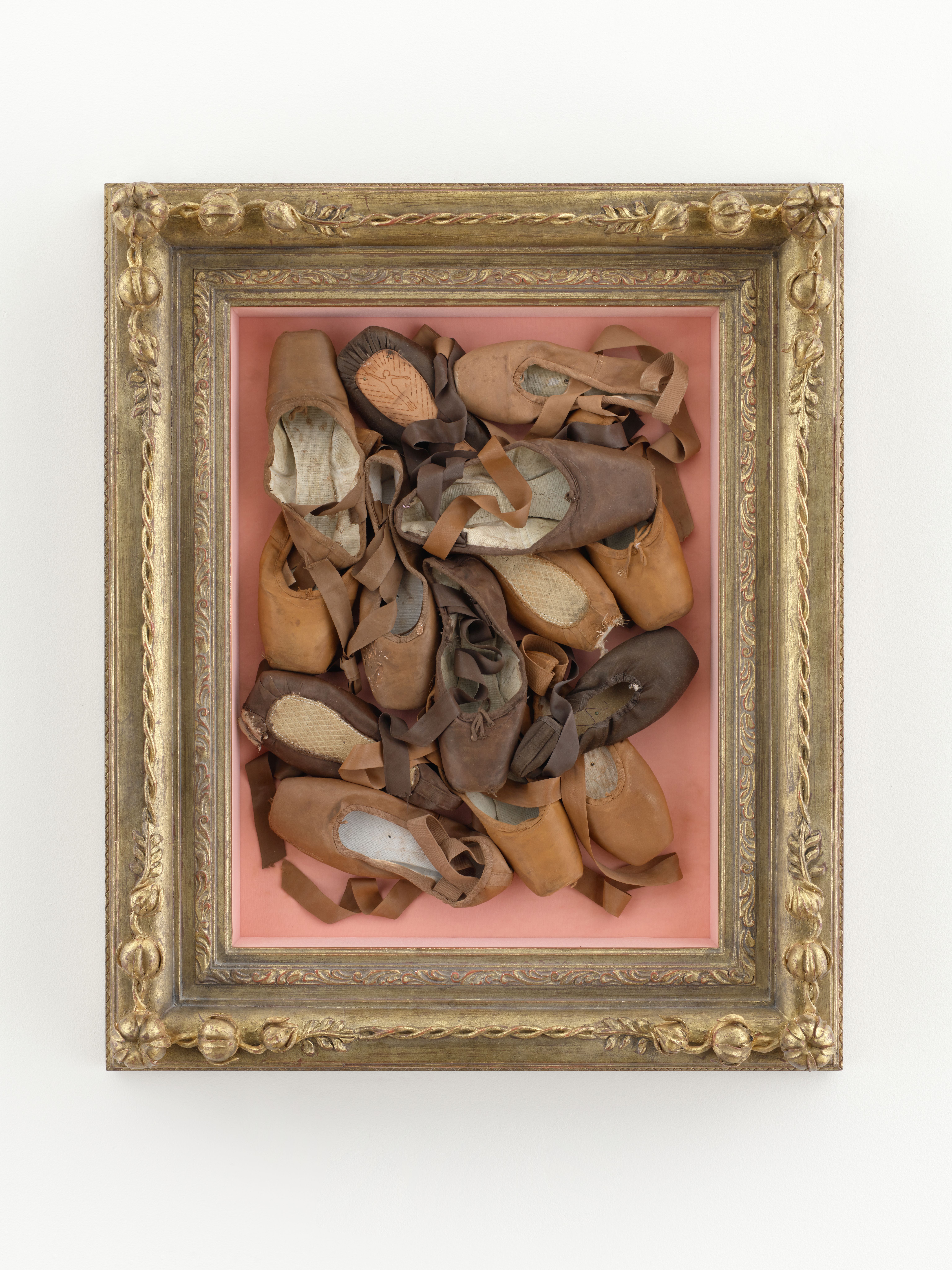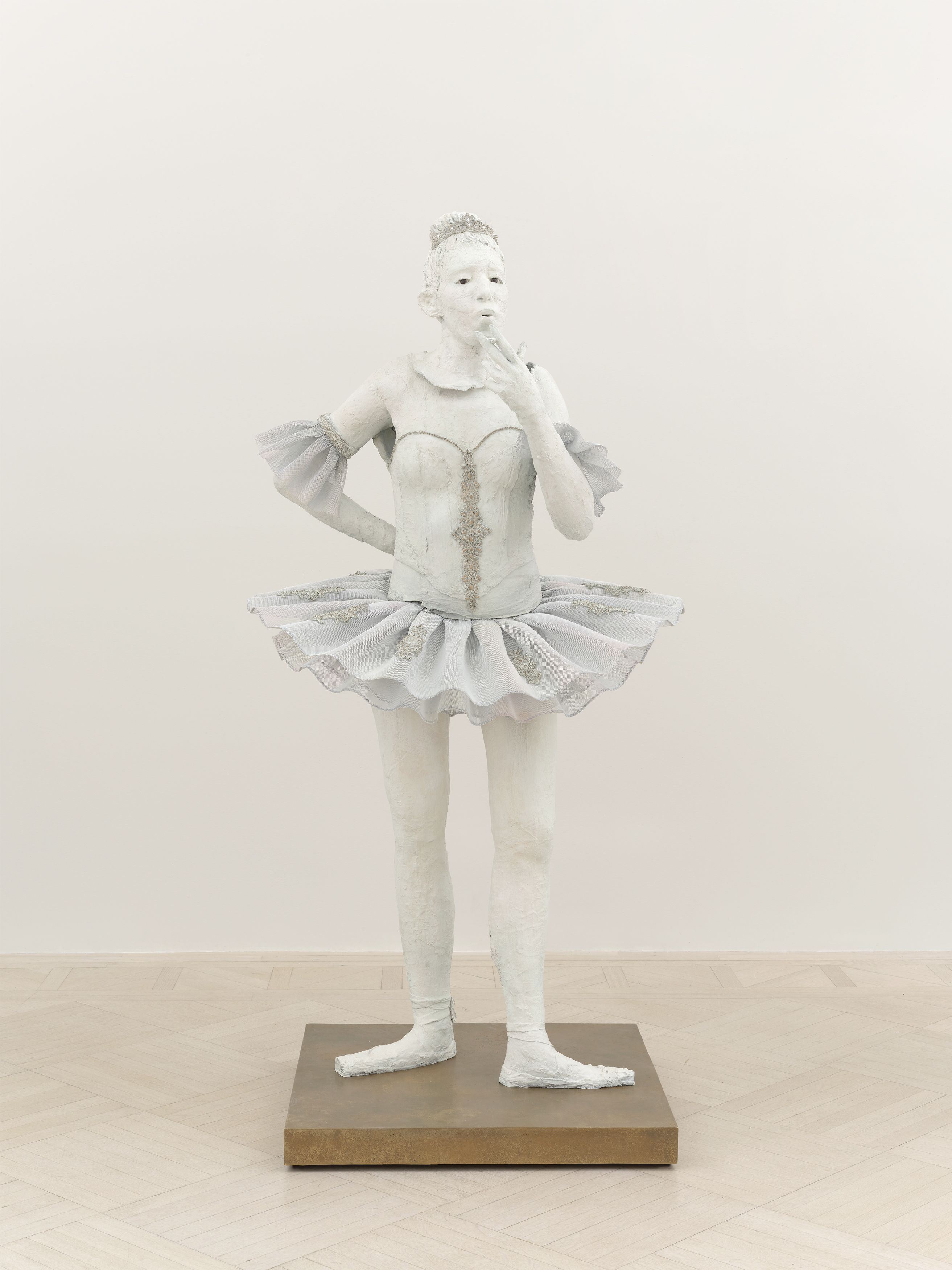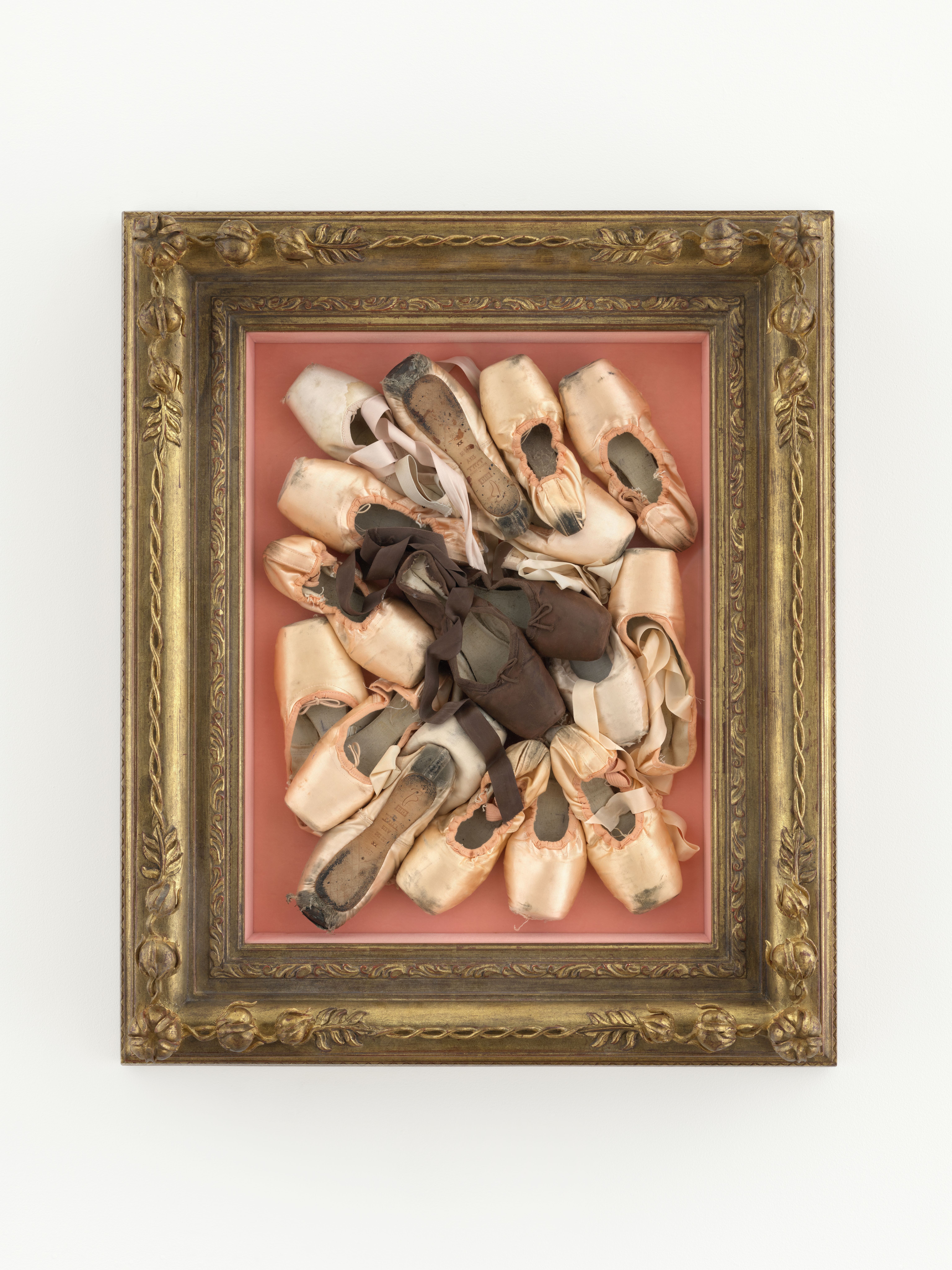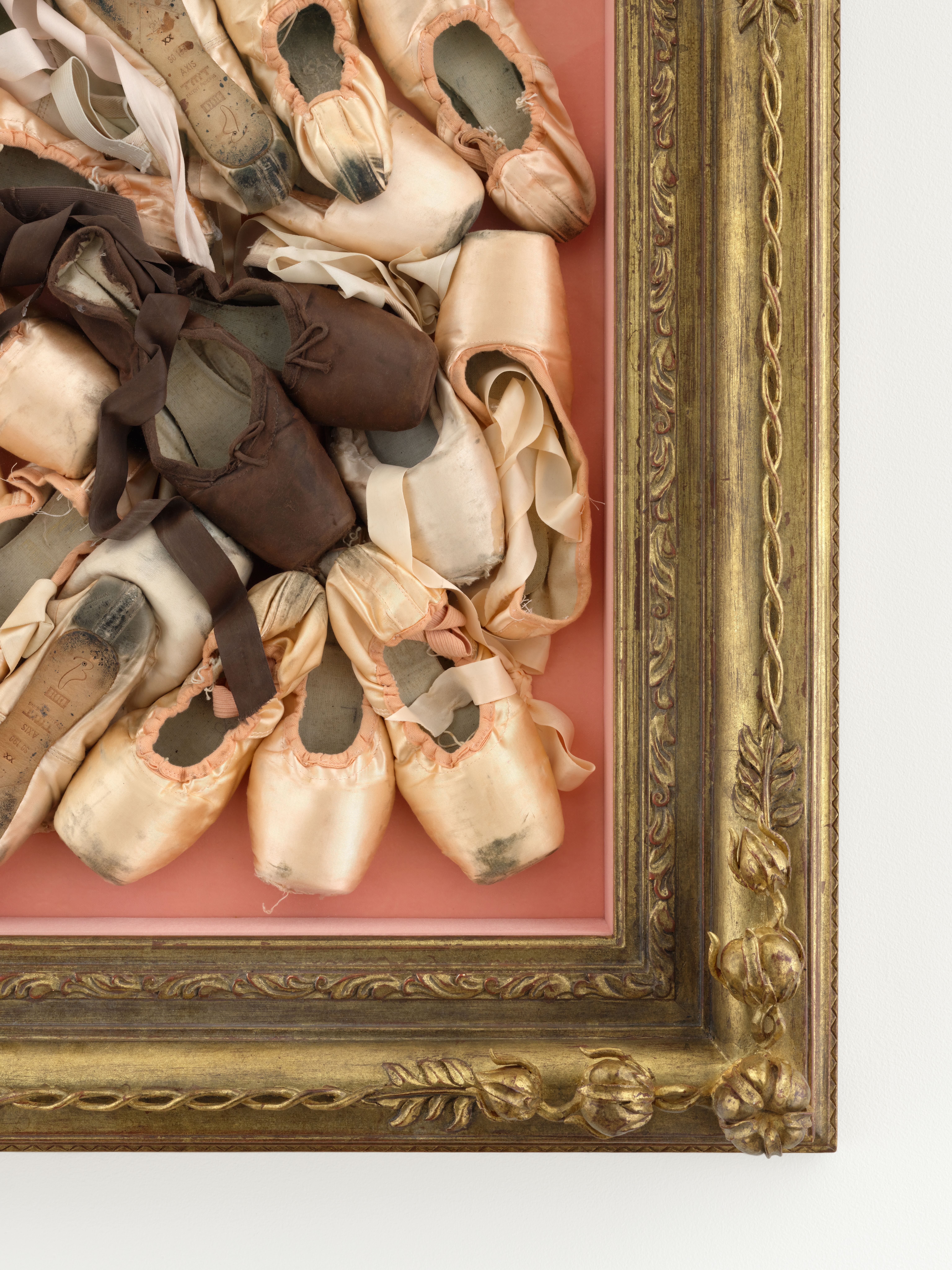
Karon DavisBeauty Must Suffer
The exhibition traces the life and labor of Black dancers, from the first encounter with the barre to the final bow
Installation Views
Artwork
My Friend Karon
By Helen Molesworth
It’s not always the easiest thing, writing about your friends. It’s tough to know where the lines should be drawn, if they need to be drawn at all. Many years ago, I presented an exhibition of photographs by the artist Moyra Davey. Davey had been the TA for my senior-year History of Photography course. For a while we lived together in an apartment rented by the boys we were dating. While our friendship has ebbed and flowed due entirely to where I happened to be living, she remains a constant in my life. When I asked my then-colleague—the extraordinary film curator Bill Horrigan, who was also a friend of Moyra’s—if he thought it was too nepotistic of me to do a show of her work, he sagely said, “If love is the motivation and container of your interests, then it can’t be wrong.” I breathed a sigh of relief at the freedom he offered me, permission to befriend the artists whose work I found interesting, permission to let myself be guided by love.
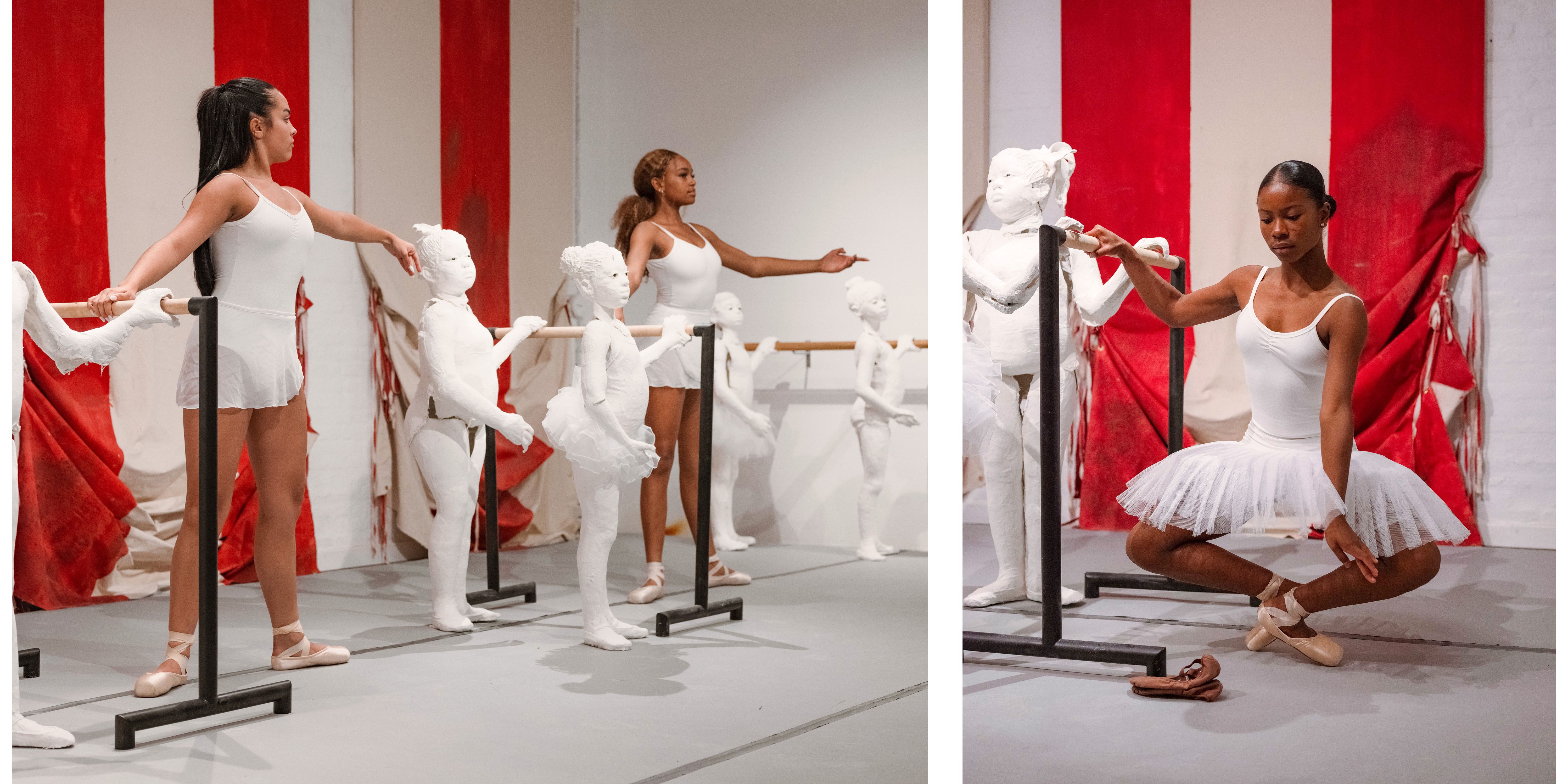
Beauty Must Suffer, LA Studio Preview, 2023.
When Karon Davis and I first met, she was not active as an “artist.” She was fully inhabiting the role of nurse, trying valiantly to keep her terminally ill husband, the artist Noah Davis, alive and well. It’s not that she wasn’t an artist—she was already making sculpture and had experimented with film—it’s just that she had much more pressing issues at hand. So I wasn’t surprised when her first gallery exhibition in the wake of her husband’s passing was called Pain Management and included a giant Kleenex tissue box and three sculptures of exhausted and somewhat dejected nurses, each of which had been filled with years of shredded medical bills. In the back room there was an installation that conjured the inhumanity of your typical doctor’s office waiting room.
But before you got to the specificity of this generic room—the clock on the wall, the Home Depot potted plant, the sentimental framed prints on the wall, the horrible upholstery—you had to walk through the first gallery, which contained a multipart work called The Children of the Moon. The piece was arranged such that as you walked through the plate glass doors into the gallery you were immediately in the midst of the piece. There was no acclimation period. The figures were there to greet you like sentinels, although their offering was one of muteness. Their gazes were either skyward or earthbound. A scarecrow-like figure hung on a cross on the wall, a last-ditch attempt to scare off the troubles. The show opened in September, the start of the season, a few days before the autumnal equinox, that time when our bodies instinctively hum with back-to-school energy. The show opened a year and a fortnight after Noah’s death. She’d made it through all the firsts—first birthday, Mother’s Day, Christmas, wedding anniversary, fill-in-the-blank—without him. The two rooms of sculptures said, “I’m looking forward and backward at the same time.” They said, “I’m exhausted.” They said, “I can do this.” They said, “Everyone is moving on without me.” They said, “I am going on without him.” They said, “I’m lonely.” They said all the things people in grief cannot say out loud.
Art is many things; sometimes it’s therapeutic, sometimes it’s healing. And while Karon was working in her studio in the first years after her husband’s passing, that’s what she was doing—grieving, mourning, healing. But the work of making art was already taking hold, because the exhibition wasn’t only about Karon and her grief and her loss. Pain Management did what art often does: it used a kernel of personal truth to say something larger. The exhibition was a mashup of sorts; in the first room you walked into a tableau, a scene, a stage, a film set. The orientation of all the figures was toward the entrance, so the effect was not unlike walking into a party that was also a diorama. The fourth wall was broken; once you entered the space you became part of the installation. There was no barrier between the viewer’s body and the sculptural bodies on view. The second room changed the tenor. Gone was any sentimentality brought on by the confluence of moonlight and children; instead, the painful, quotidian reality of the world was front and center. Karon the artist was manipulating time and space. She was creating different moods and feelings. It also felt like an announcement of sorts. She had found her métier—cast figures made by wrapping human beings (friends, children, family members) in bandages soaked with dazzling-white plaster of Paris.
Karon Davis (Taurus) was born into a large and loving family of four siblings. Her mother and father met while dancing. Once the children arrived her mother, Nancy Bruner, like so many women of her generation, raised the kids and left showbiz behind. Her father, Ben Vereen, would go on to become one of the last song-and-dance men around, a true entertainer. He was at home just as much on a Broadway stage (Bob Fosse’s Pippin) as he was in one of the most galvanizing television events of the 1970s—he played Chicken George in Alex Haley’s Roots. Karon would go on to study ballet and modern dance at Spelman College. She made her way out to Los Angeles and went to film school. She experimented with making movies. She researched the Black cowboys of Oklahoma. She hunted down the legacy of Black Hollywood in West Adams. She met the artist Noah Davis. They married in a wedding chapel in Miami during Art Basel. They had a baby named Moses. They lived, for a time, in a run of four storefronts in Los Angeles that, once renovated, would ultimately become the legendary Underground Museum.
One night, during one of the long days of the pandemic lockdown, I lay on my sofa, long past the time when everyone else in my household had gone to bed, and watched Bob Fosse’s Cabaret. During the first dance scene I paused the film because all I could think about was my friend Karon. Her jazz hands, the way she can belt out a show tune, the way she sometimes glides into a room as if on a camera dolly, her head wraps and huge crystal jewelry, her dazzling smile, that time in Miami when she dropped into a full squat on the dance floor in stilettos. My friend Karon who grew up between New York and LA, between the twentieth century and the twenty-first. And then I thought about her sculptures. All those frozen bodies. All those bodies whose magic comes from the passing quality of their gesture: the tilt of a chin, the angle of a head, the slight rise of a shoulder, the weight shifting from one foot to another, the sway of a back, the protruding belly of a child, the crossed arms of an adult. I realized that the catalogue of bodily gestures one finds in her work have different temperatures. It occurred to me there was Broadway Karon and Hollywood Karon. Broadway Karon is all about the proscenium stage and the red velvet seats that hold the audience. Broadway Karon knows that the performers must fill the entire theater with energy. Each night singers, dancers, and actors play in front of a live audience that in turn assembles itself into some kind of unified organism. The singing and dancing that make Broadway Broadway are a mashup of the European tradition of opera and the American tradition of vaudeville. To sing and dance on Broadway is to defy subtlety. Gestures are grand, emotions are profound, life is dramatic. You know the drill: the show must go on. There is a residue of this in Karon’s tableaux. Her figures carve out the space around them. They behave as if they have all stopped moving on cue, to the beat, everything simultaneously coming alive and freezing all at once. The high style of it all. The exaggeration of the basic. And then there’s Hollywood Karon, whose reference point is not the stage, but the glamour of the silver screen and the truthy black and white of the documentary. Or this is how I read Karon’s continual use of glass eyes in her figures. If the gestures of her sculptures remind me of Broadway, then the eyes recall cinema. As they catch and refract the sharp white light of the art gallery, they hint at emotions that run below the epidermis, below the threshold of speech. If Broadway is governed by gesture, then cinema conveys its magic through the regimes of the glance, the look, the gaze. In the movies all of that looking and watching is in the service of narrative, which helps make sense of how Karon’s work is offered in the form of a tableau, complete with a descriptive title, both of which are explicit in their desire to tell you a story. The genius of Bob Fosse was that he was able move fluidly between the heat of Broadway and the coolness of Hollywood. The genius of my friend Karon is that she does both without recourse to movement, music, or language. Her figures stand, kneel, skip, crouch, and jump for eternity. After I thought all that, I pressed play and resumed watching Cabaret.
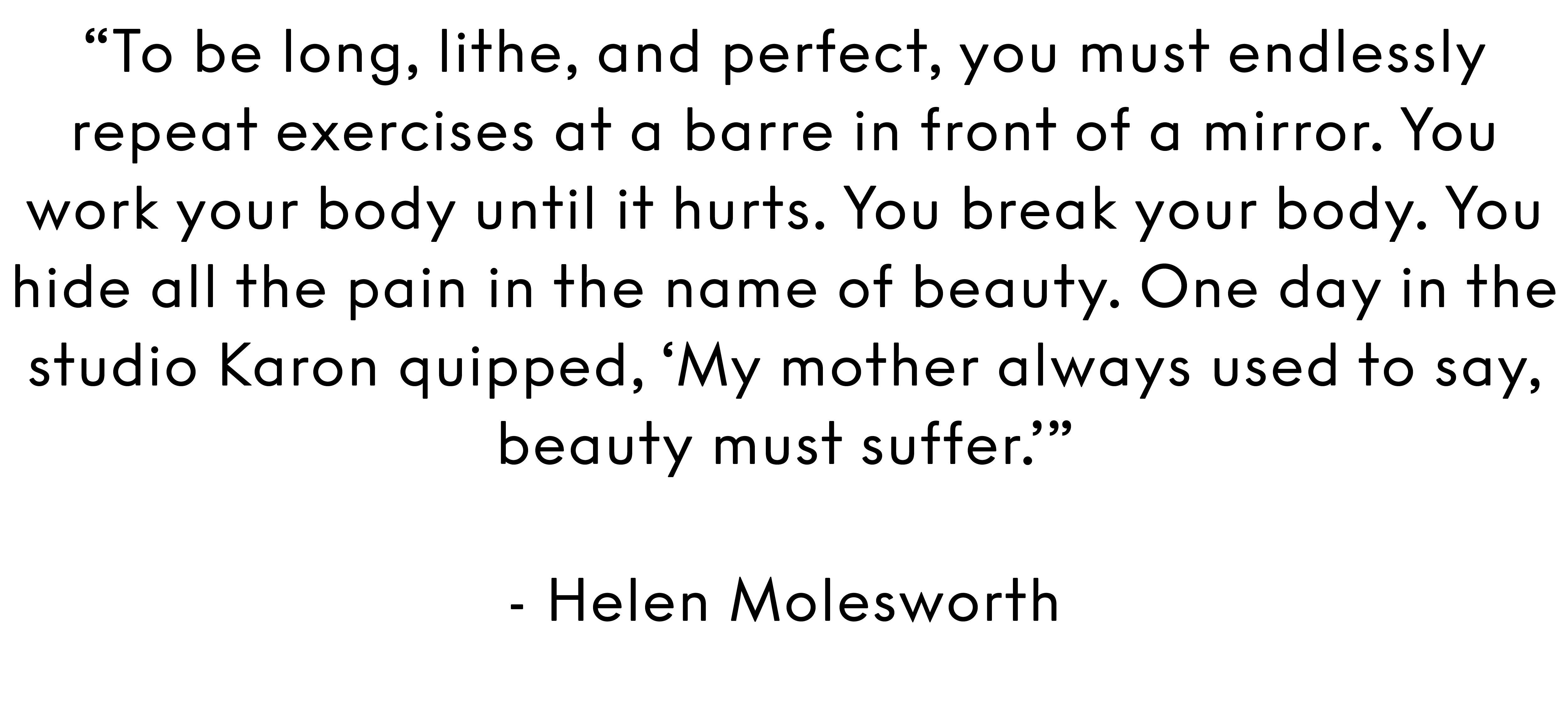
As Karon’s work has grown in scale and scope, it has morphed and shapeshifted. She has offered us her joyous sculpture of three little girls playing double Dutch while watched over by an impossibly large nun, as well as a terrifying rendering of Black Panther Bobby Seale bound and gagged by a white Chicago judge in her magisterial installation No Good Deed Goes Unpunished. Her work’s emotional range is nothing if not capacious. What remains constant is the bright white of her materials, which is counterintuitive in the extreme as the bodies she casts are invariably Black—counterintuitive, that is, until the gestures make it plain that Blackness is not a color. Blackness is a state of feeling, a mode of existence, a set of beliefs and strategies born of the diaspora. The white of her work announces that these figures are separate from the world, accentuating their identity as art. The white is riding slipstream on the long history of classical sculpture stripped of its color and ornamentation. When color appears in Karon’s work it is offered as a readymade—the color of the costume, the pink of a little girl blowing a bubble, the blood red of a bouquet of roses. These imported colors tend to make the whiteness of the figures even more dazzling. And this “extra” whiteness acts as such a powerful reminder of the classical sculpture of the Greco-Roman period, artworks foundational to our conception of beauty in the West—although by now we know that these sculptures were once highly decorated and painted. The passage of time stripped them of their color, and it turns out we love this modern whitewashing. Along with our Victorian foremothers, we imagine that it permits a purer apprehension of form. And, in some ways, this old modernist sawhorse about the purity of form rings true, for Karon manipulates the power of white as a kind of erasure. She uses white to eliminate the details, which allows her to revel in the emotional resonance of the gesture. Instead of getting hung up on color, Karon’s work stages gesture as both ineffable and performative.
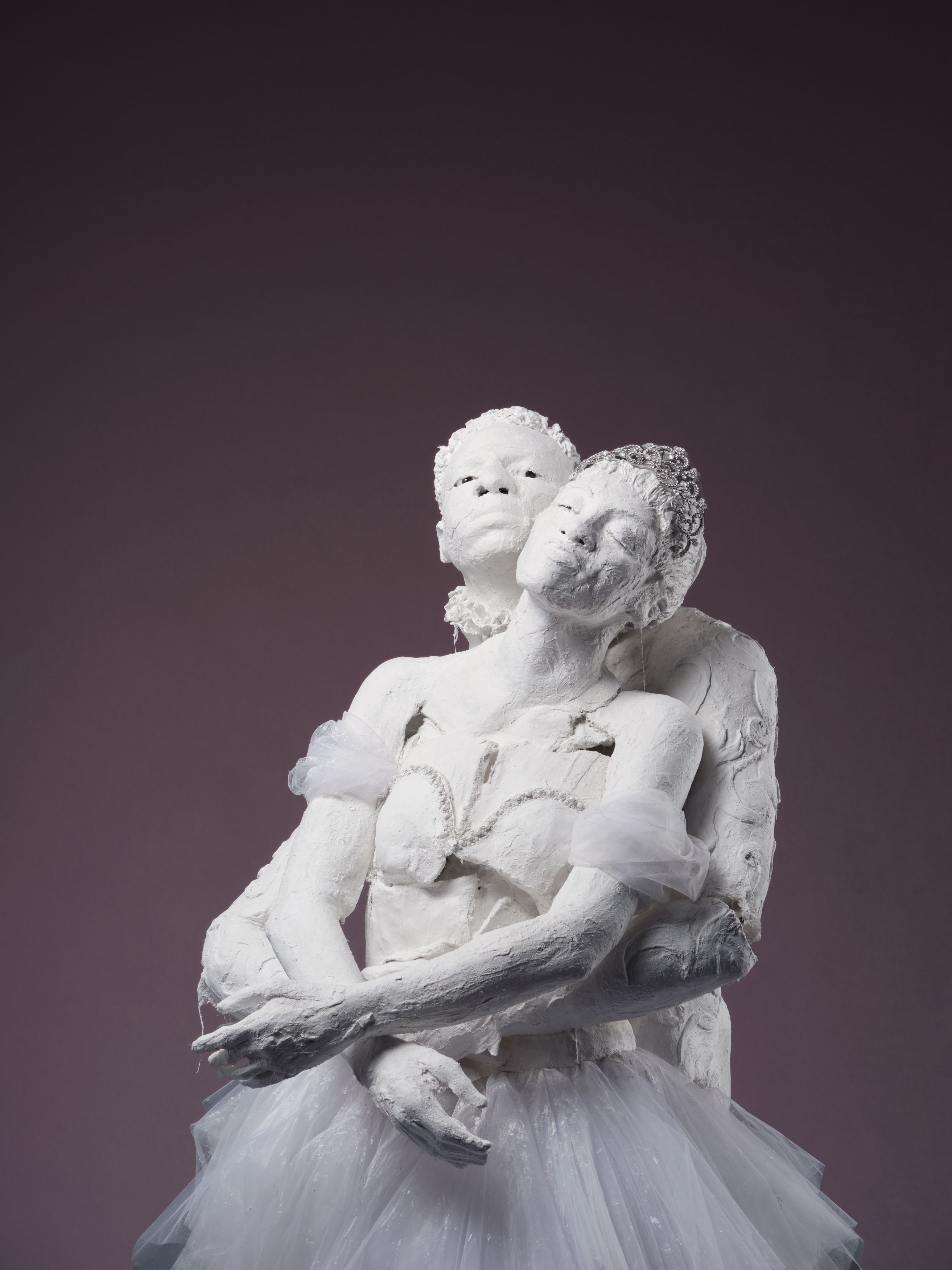
Karon Davis, Echo & Narcissus: The Embrace, 2023
Then there’s Echo and Narcissus. Poor Echo can only say the last words of every sentence she hears, and Narcissus is doomed to not recognize his reflection as his own. It’s a Greek myth of unrequited love, in which Echo falls in love with Narcissus and Narcissus falls in love with his reflection and all gratification is forever tragically deferred. Staged at the beginning of the twentieth century by the Ballets Russes, it is a myth that perpetually returns, striking, as it does, the deep human chords of repetition and despair, entrapment and desire. And now that we all live in an echo chamber of our own algorithms, the figure of the narcissist appears to be the governing personality type of our age. Karon has combined these mythic constraints with the ruthless rigor of the ballet, an art form in which conformity to Western (read: white) beauty standards is unflinching. To be long, lithe, and perfect, you must endlessly repeat exercises at a barre in front of a mirror. You work your body until it hurts. You break your body. You hide all the pain in the name of beauty. One day in the studio Karon quipped, “My mother always used to say, ‘beauty must suffer.’” Karon’s figures have shown us the price of the suffering from the beginning, for her sculpted bodies have never been whole or seamless. They have never been protected by a layer of muscle, fat, and skin. Instead, her bodies are all broken forms, carapaces underneath which we can sometimes see the steel armatures that gird their delicacy. These splits or cuts in the body are a trace of the process of live casting; they show us the seams where an actual body once was. These openings appear as you walk around the works. Even though I’ve seen enough of Karon’s work by now to know they’ll be there, they still tend to creep up on me. I’m always taken in by the drama of the mise-en-scène. I love the low-hum shock of the figures arching and cutting their way through space. After I settle down a bit, I can move around and through the figures, and when I do so I often feel my own aliveness, the texture of my skin and hair, the reality of my body in space. It’s only then that I can face the melancholy of all those cracks and fissures, all those fragments and pieces, all those torn parts, all the hollowness inside. When I am in and among the pieces, when I enter the tableau, that’s when I feel the depth of my friend Karon’s emotional and aesthetic capacity. That’s when I know that the undertow—perhaps even the riptide—of her project is to balance us ever so precariously in between the joy of these bodies’ exuberance, the tensile quality of their beauty, and the pain each of us carries, all the little hurts and all the big ones too. This newest body of work, Beauty Must Suffer, shows us how beauty and joy and pain and brokenness are forever entangled. And those glass eyes stay open through it all, for that is both the task and privilege of gracing this earth in this utterly transitory and glorious form.
Beauty Must Suffer will extend on New York's High Line in Chelsea with the unveiling of Curtain Call (2023), a large scale bowing ballerina in bronze, in December 2023.
For additional information on the work of Karon Davis, please contact Andrew Blackley (andrew@salon94.com) or Nicolas Ochart (nicolas@salon94.com).
For press inquiries, please contact Michelle Than (michelle@companyagenda.com).
Press
The Guardian
Dance Magazine
The New York Times
CULTURED
